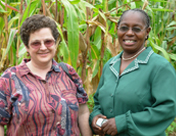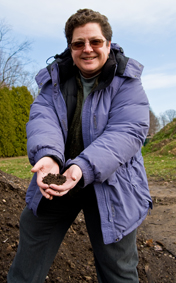Short- vs. Long-Term Goals in Agriculture: Mediating the Trade-offs
- Sieglinde S. Snapp
- Associate Professor
- Department of Crop & Soil Sciences and Kellogg Biological Station
- College of Agriculture and Natural Resources

Sieg Snapp (L) and Ms. Mazungu (R), a technical assistant and farmer in Zomba, Malawi, in front a perennial legume/maize interplanting. The two have worked together for almost 15 years.
Sieg Snapp is fascinated by how farmers make decisions. "There's a gap between what researchers are interested in and what farmers want," she said. "Researchers want long-term trials; farmers want results right now."
Dr. Snapp sees her job as bridging the gap between the two. "It's an area that MSU is good at," she said. "What we do is link ecological knowledge with stakeholder experience."

Staying in the black: Cover crops can help develop soil biodiversity and resilience.
A few years ago, while she was working in Africa, Snapp pioneered a method for doing just that. Her process has been dubbed "mother-and-baby trials." Researchers at a large, centrally located "mother" site test new technologies using conventional experimental designs. Smaller "baby" trials, carried out at participating farms nearby, allow the farmers to select the specific new technologies they are interested in for what Snapp calls a "relevancy test" of labor costs and other practical issues.
"We start by building an advisory group of farmers, educators, and buyers," said Snapp, "and bring the best ideas to long-term research trials. Then it's back to the farmers to pick from those, and back again to the researchers for broader applications. We always include a farmer pick and a researcher pick. Agricultural research has to have both short- and long-term uses."
The tradeoff point between short- and longterm benefits is a classic problem in agriculture. High-yield plantings are more profitable, but can deplete the soil. On the other hand, farmers may not be able to wait for the 10 years or so it takes a cover crop (a planting intended to prevent erosion from bare fields over winter) to develop soil biodiversity and resilience. They may not have the resources to apply a cover crop in the first place.
Snapp believes that the key to solving the dilemma is finding approaches that mediate between these needs. "In Malawi, we found that farmers were more likely to plant a diversified cover if it had a small bonus value such as something to sell, or to feed to their children. And solutions are very location-specific. Livestock are common in Zimbabwe, so using manure is a feasible option there. There isn't much livestock in Malawi, so it isn't an option."
Snapp continues to learn from collaborating with farmers. "Farmers want to know the underlying biology," she said. "If our recommendations don't work, they want to know why. The industry is innovative. It changes fast. Clean water, soil quality, biodiversity—productivity is primary, but we also need to protect the land."
"Mother-and-Baby" Trials are Used Around the World
- Researchers are using Dr. Snapp's trial design in Africa (15 countries), Southeast Asia (6 countries), and Latin America (5 countries).
- A 2006 article by Lançon et al.1 noted that "the design was...particularly welcomed by the farmers, and could be the central piece of a participatory evaluation design in an organised sector."
- A 2003 "Success Stories" bulletin from International Center for Soil Fertility and Agricultural Development (IFDC)2 reported that based on exposure to the "Mother-Baby" trials and farmer feedback, several new varieties of maize had entered the national certification process for release in Kenya.
- Lançon, J., Lewicki, S., Viot, C., Djaboutou, M., Cousiño, J.-C., & Sêkloka, E. (2006). Creating bonds in the cotton sector: Participatory breeding in Benin and Paraguay. Cahiers Agricultures, 15, 92-99.
Go back to Citation 1
- International Center for Soil Fertility and Agricultural Development. (2003). Managing soil, water and nutrients for maize based cropping systems in eastern Africa. Retrieved June 10, 2009, from ifdc.org.
Go back to Citation 2